SnO2/Perovskite Buried Interfacial Modification for Efficient and Stable Perovskite Solar Cells
IF 4.1
2区 工程技术
Q2 ENGINEERING, ELECTRICAL & ELECTRONIC
引用次数: 0
Abstract
Organic-inorganic halide perovskite solar cells (PSCs) with n-i-p architectures exhibit significant potential for commercialization owing to their impressive power conversion efficiency and chemical stability. However, interfacial defects between electron transport layers (ETLs) and perovskite films present a critical challenge that significantly limits the photovoltaic performance. Here, we introduce 5-(trifluoromethyl) pyridine-2-carboxylic acid (TPCA) as a multifunctional interfacial modifier at the SnO2/perovskite buried interface. TPCA effectively passivates Sn-OH dangling bonds on the SnO2 surface while modulating surface energy to guide the crystallization of perovskite films. Through this synergistic mechanism combining chemical passivation and physical modulation, the maximum power conversion efficiency (PCE) of perovskite solar cells modified by TPCA has increased from 22.10% to 24.38%. Furthermore, unencapsulated TPCA-treated PSCs maintained 90.7% of their initial efficiency after 1,000 hours, showing superior long-term stability. This work provides a practical interface engineering approach to advance both efficiency and stability in perovskite optoelectronics.SnO2/钙钛矿埋藏界面改性制备高效稳定的钙钛矿太阳能电池
具有n-i-p结构的有机-无机卤化物钙钛矿太阳能电池(PSCs)由于其令人印象深刻的功率转换效率和化学稳定性,显示出巨大的商业化潜力。然而,电子传输层(etl)和钙钛矿薄膜之间的界面缺陷是一个关键的挑战,它极大地限制了光伏性能。在此,我们引入了5-(三氟甲基)吡啶-2-羧酸(TPCA)作为SnO2/钙钛矿埋藏界面的多功能界面改性剂。TPCA可以有效钝化SnO2表面的Sn-OH悬空键,同时调节表面能,引导钙钛矿薄膜的结晶。通过化学钝化和物理调制相结合的协同机制,TPCA改性钙钛矿太阳能电池的最大功率转换效率(PCE)由22.10%提高到24.38%。此外,未封装的tpca处理的psc在1000小时后保持了90.7%的初始效率,表现出优异的长期稳定性。这项工作为提高钙钛矿光电子学的效率和稳定性提供了一种实用的界面工程方法。
本文章由计算机程序翻译,如有差异,请以英文原文为准。
求助全文
约1分钟内获得全文
求助全文
来源期刊

IEEE Electron Device Letters
工程技术-工程:电子与电气
CiteScore
8.20
自引率
10.20%
发文量
551
审稿时长
1.4 months
期刊介绍:
IEEE Electron Device Letters publishes original and significant contributions relating to the theory, modeling, design, performance and reliability of electron and ion integrated circuit devices and interconnects, involving insulators, metals, organic materials, micro-plasmas, semiconductors, quantum-effect structures, vacuum devices, and emerging materials with applications in bioelectronics, biomedical electronics, computation, communications, displays, microelectromechanics, imaging, micro-actuators, nanoelectronics, optoelectronics, photovoltaics, power ICs and micro-sensors.
 求助内容:
求助内容: 应助结果提醒方式:
应助结果提醒方式:


